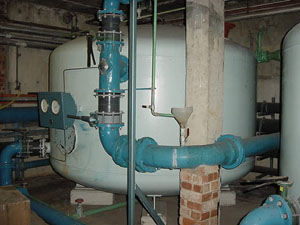Filters |
||
| WATER The Water Cycle Water in a Pool Water compared Pool Processes POOL PROCESSES CHEMISTRY IN OZONE DISINFECTION NEW IDEAS Hannah Morgan, University of Bristol, School of Chemistry, hm9921@bris.ac.uk |
Clarity is critical, it must be possible to see the bottom of the pool at its deepest point. Disinfection is also compromised by reduced clarity, at the most, water must have a value of 0.5 NTU, (Nephelometric turbidity units) Clarity is reduced by turbidity, which is colloidal or particulate matter in suspension in the water. This can be dealt with directly by adequate filtration and backwashing coupled with coagulation (flocculation) to convert the colloids into filterable flocculus or flocs. The greater the filtration velocity, the lower the filtration efficiency. Sand filters are usually used - filtration is normally achieved by rapid gravity or pressure is generated inside a sealed filter vessel. Loss of pressure through the filter is directly proportional to filtration velocity within the range of 10-25 m/hour. Non domestic pools use multigrade beds, which have a number of layers of course media under about 550mm of sand. The filters have a layer of coagulant which sits on the top of the filters, this kills any infective cysts of Cryptosporidum and Giardia, and also removes humic acid - a significant precursor of trihalomethanes, and phosphate. The filters are also cleaned by a process of backwashing. A multigrade sand filter
|
